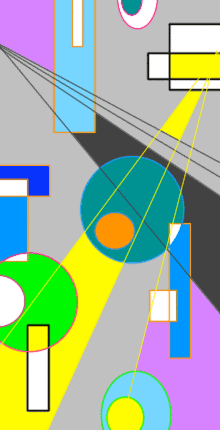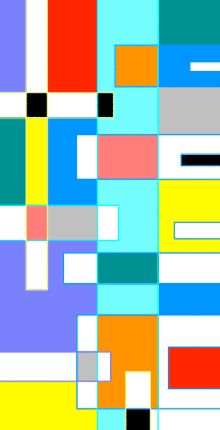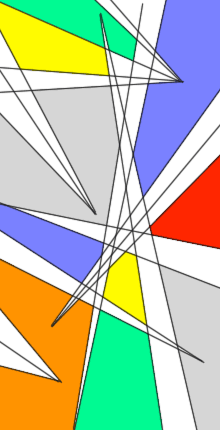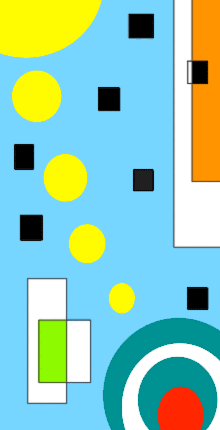From Art to Science, and back to Art
- Martin Calvino
- May 19, 2016
- 5 min read
This post is derived from the abstract of my talk at the 'Second Virtual Symposium on Information & Technology in the Arts & Humanities' (http://www.asis.org/SIG/SIGAH/2016/01/15/2016-symposium)that took place on May 18, 2016.
Art was always there
Art has always been present as core component of my upbringing. I still remember my father's request to re-create the brightness of an apple's color when drawing and coloring during my childhood years. During that time, I also came into contact with books written about the work of Uruguayan painters Pedro Figari, Joaquín Torres García, Rafael Barradas, and José Cuneo as well as the works of internationally acclaimed artists Joan Miró and Paul Gauguin.
At the age of fourteen, I've already decided on what my artistic style would be like, and I defined it at the intersection of the universal constructivism of Torres García with the surrealism of Miró. From that moment on, I've been constantly sketching abstract drawings on innumerable pieces of paper that came across.
Figure 1. Shown are two examples of abstract drawings I made with a black sharpie on paper during 2008.
From black & white to colors
In August of 2011, my artistic impulse started to flourish to new levels and my wife realized that my innate curiosity for self-expression could be expanded beyond paper and gave me as birthday's present a set of canvases, brushes and acrylic paints to start experimenting in a new medium with the addition of colors.
Figure 2. Shown are a series photographs of works painted with acrylic on canvas.
In November of 2013 I decided to showcase my paintings at a local coffee shop in Highland Park, NJ with the end result of thirteen works sold from the fifteen that were on display. From that moment on I knew for the first time that my work could indeed be well accepted by the public. This experience stimulated me to keep experimenting in search of an artistic identity in addition to my formal education in plant molecular genetics while in graduate school at Rutgers University.
Science meets art
A concrete opportunity to integrate artistic curiosity with scientific activities occurred when writing a paper for publication in the field of grass comparative genomics. I came to realize then that the graphs (like the one shown on Figure 3) I prepared to communicate my findings had a high degree of artistic abstraction and aesthetic sensibility. I remember thinking at the time: 'wow, this is kind of art ...', and that impression stayed with me as testimony of artistic curiosity mixed with analytical thinking.

Figure 3. Syntenic alignment of rice and sorghum chromosomal segments containing MIR169 gene clusters. Sorghum MIR169 gene clusters on chr2 and chr7 together with their flanking protein coding genes were aligned with rice by orthologous gene pairs. Rice and sorghum chromosomes are represented as horizontal lines, whereas genes along the chromosome are represented as rectangle bars. Known MIR169 gene copies are shown as red bars, whereas new MIR169 gene copies described in this study are shown as green bars. The bHLH and B-box zinc finger and CCT motif (B-box/CCT) genes are represented as yellow bars. All other protein coding genes in the chromosomal regions under study are represented as black bars. Orthologous gene pairs are indicated as lines connecting bars, with red lines indicating orthology between MIR169 gene pairs and yellow lines indicating orthology between bHLH and B-box/CCT gene pairs, respectively. All other orthology between rice and sorghum protein coding genes are indicated as black lines connecting black bars. The physical distance between bHLH and B-box/CCT genes and/or between bHLH or B-Box/CCT genes to the flanking MIR169 copy is indicated. To provide a scale of the chromosomal segments highlighted in the figure, the physical distance between the first and the last gene in the segment is indicated and thus serves as a reference to observe expansion and contraction of genomic regions. An inversion event on sorghum chr7 containing the MIR169 cluster occurred relative to the orthologous regions on sorghum chr2 and rice chr8 and chr9 respectively.
Entrepreneurship meets art
In 2014 I started my own company and worked towards the development of knowledge visualization software with the aim to glance particular fields of knowledge from a visual perspective. The integration of abstract art with principles of user experience and design was a conscious effort at the time.
As I worked with developers in the creation of software features that involved interactive graphs and visualization diagrams, I made sure artistic elements were included in the process. Indeed, not only the software had components that could be considered 'abstract art' but also the webpage hosting the cloud-based tool had 'digital art' on it.

Figure 4. Figure from QiWord's massive downloader feature in which open access journals were represented by colored circles. The diameter of each circle was proportional to the number of articles containing a given keyword that were ready for download whereas the intensity of each circle's color corresponded to the impact factor of the journal. The design was conceived by Martin Calvino with implementation by Neil Deshmund. For more information about QiWord's functionalities please watch our youtube video at:
Artist full time
The experience explained above stimulated in me a strong interest in the application of coding to art. In October of 2015 I decided I wanted to take an extended time, that is a sabbatical year, to reflect, explore, and re-invent myself with art and technology at the epicenter of change.
Exploring digital art & creative coding
I am currently using computers to create abstract art in four different formats:
(a) drawing digitization
(b) digital painting
(c) animated GIFs
(d) art made with code (termed DevArt herein)
Digitization of drawings merely involves taking a photograph and/or scanning of drawing made by hand for later coloring on the computer. I like this approach because allows me to keep drawing on paper while taking advantage of applying different coloring patterns on the computer to the same black & white backbone drawing.
Figure 5. A digitized drawing is shown together with two different versions of it painted with computer software.
I also create abstract art entirely on the computer by using a designer's pad and the associated software. This allow for more precise definition on the stroke and has the advantage of easily combining art with photography, bringing the two worlds if needed. Animated artwork is more easily generated as well.


Figure 6. Two works are shown that were created using a designer's pad and its corresponding software.
Art can be animated as well, adding a temporal dimension to the work as shapes and colors change over time. Abstract art in the form of animated GIFs can be appreciated when viewed on the browser and allows for a different for of expression, one that focus on visual engagement through constant change.
Figure 7. Mural series created as animated GIFs.
Programming computers to help me create compelling abstract art is an area of intense interest for me. The artworks created can be static or animated and elements of randomness can be included as mechanism to generate abstract patterns without much prior pre-conception, adding an element of uncertainty on the aesthetic outcome. The work is always at the intersection of my creativity with the coding skills developed at any moment, is the product of trade-offs between visual thinking and programming capacity.

Figure 8. Interestellar 2016: and static image of artwork created with code.
Creating added value
What I like about digital art is that the computer screen becomes the medium in which the artwork is appreciated. The cover photo from social media user's profile can be then considered as canvas space in which digital art can drive. Indeed, I have started to explore such concept by creating my first collection of art made with code tailored specifically as Facebook's cover image, and I am very excited to continue working on such efforts for the time to come.


Figure 9. Atardecer Geometrico 2016: art made with code to be used as Facebook's cover image.
Upcoming work
I am diligently working on creating my first book in order to publish printed editions of my digital artwork together with accompanying essays explaining the intentions behind each art piece.
Keywords: Martin Calvino; digital art; science; ArtScience;





























Comments